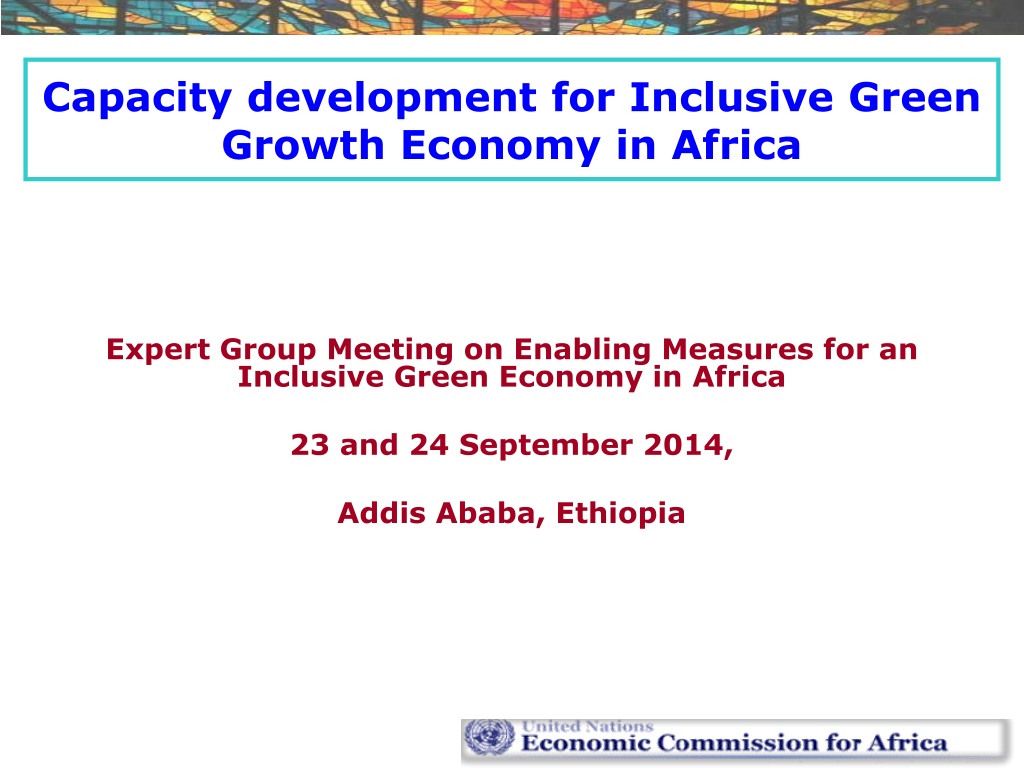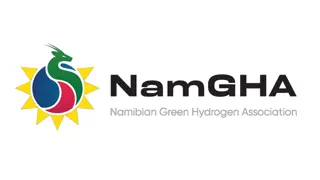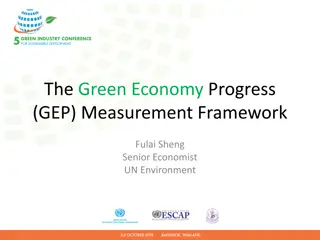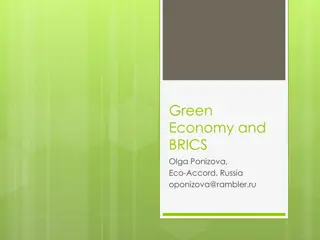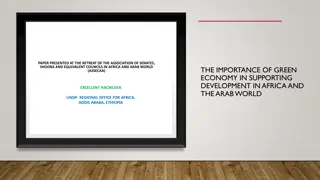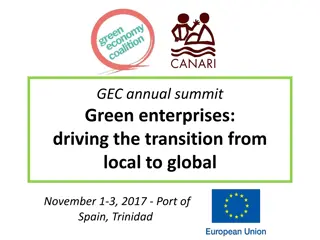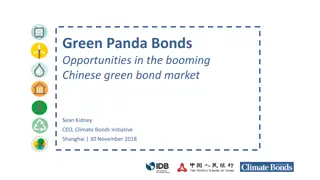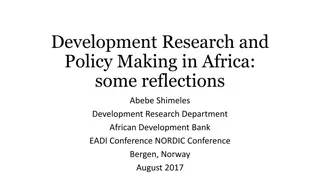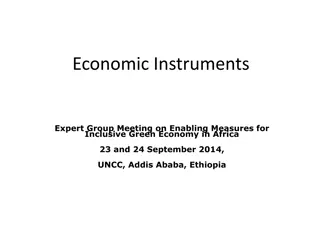Capacity Development for Inclusive Green Growth Economy in Africa Expert Group Meeting
The expert group meeting in Addis Ababa discussed the role of capacity development in achieving an inclusive green economy in Africa. It highlighted the importance of enhancing awareness, skills, policy formulation, and technology innovation at individual, organizational, and societal levels to promote green growth. Challenges, opportunities, and recommendations were outlined to strengthen capacity for sustainable development.
Download Presentation

Please find below an Image/Link to download the presentation.
The content on the website is provided AS IS for your information and personal use only. It may not be sold, licensed, or shared on other websites without obtaining consent from the author. Download presentation by click this link. If you encounter any issues during the download, it is possible that the publisher has removed the file from their server.
E N D
Presentation Transcript
Capacity development for Inclusive Green Growth Economy in Africa Expert Group Meeting on Enabling Measures for an Inclusive Green Economy in Africa 23 and 24 September 2014, Addis Ababa, Ethiopia
Outline 1. Introduction 2. Role of capacity development in achieving inclusive green economy (IGE) 3. Trends and gaps in capacity development for inclusive green economy 4. Challenges and opportunities 5. Conclusion and Recommendations
1. Introduction Capacity Development (CD) as used in the report: Process through which individuals, groups and organisations, and societies deploy, adapt, strengthen, and maintain the capabilities to define, plan and achieve their own development objectives on an inclusive, participatory, and sustainable basis Capacity complementary levels: development is considered at three Individual Organisational or institutional Societal or enabling environment level
2. Role of capacity development in achieving inclusive green economy (IGE) Crucial role of capacity development recognized and there is demonstrated demand for it at all levels Level Capacity development 1. Individual level of Major Roles or significance of capacity development in fostering IGE Enhance IGE awareness, understanding and appreciation: Develop employable skills in green jobs labour market Support IGE policy formulation, implementation Strengthen ability to analyse opportunities and alternatives, and take decisions on IGE. Ensure effective IGE assessment and monitoring Promote technology innovation, development for IGE Mobilise financing for IGE Develop green trade planning and 2.Organisatio nal institutional level or challenges, identify research and
Role of capacity development in achieving IGE Contd. Level Capacity development 3. Enabling or Societal level of Major Roles or significance of capacity development in fostering IGE Strengthen overall policy and legislative and social norms environment within which individuals and organisations 0r institutions operate at regional levels Strengthening incentive structures to reduce employee turn-over and ensure availability of long-term capacity for IGE in the public and private sector Enhance political commitment and leadership for and popular participation in IGE. Strengthen and widen opportunities to enable people to use and expand their capacities to the fullest. national, subregional and
3. Trends and gaps in capacity development for IGE A frameworks that are inroads for capacity development to foster the transition to IGE Countries with such IGE frameworks include: Ethiopia Mozambique Rwanda South Africa Role and importance of CD is recognized Processes for the formulation frameworks themselves assisting in the identification of CD needs, priorities and approaches. Scope of the CD needs and approaches identified is uneven across the countries Some good practices in identification, delivery of CD emerged Ethiopia and Rwanda growing number of providing African countries the strategic direction are designing and of frameworks and the formulation and
Trends and gaps Cont. CD development dimensions are being identified in scoping and other studies on green economy UNEP green economy scoping (GES) studies Other studies by Institute Development (IIED), the (AfDB), and GIZ Studies do not provide wide and detailed analyses of CD interventions necessary, planned or under way Only provide a snapshot of the capacity development gaps and needs Some striking aspects : Most countries underline the need to create a good understanding of the concept of green economy Lack of implementation capacity for IGE related plans and programmes could apply to main IGE strategies for Environment Development and Bank African
Trends and gaps Cont The number of international initiatives providing support to enable the transition to green economy is growing Examples include: Green Economy Initiative (UNEP) Green Economy Joint Programme (UNDP, UNEP and UNDESA) Green Industry Initiative (UNIDO) Green, Low-Emission Capacity Building Program (UNDP) Green Jobs Programme by ILO, UNEP and other partners OECD s Green Growth Programme Global Green Growth Institute (GGGI) Partnership for Action on Green Economy (PAGE) Climate Development Knowledge Network (CDKN Global Environment Facility (GEF) Climate and forest carbon funds
Trends and gaps Contd Most (64%) of those reviewed provided support to CD A vast majority target developing countries. Africa s eight top-most beneficiary countries namely Kenya, Ethiopia, Tanzania, Uganda, Rwanda, Mali, Ghana and Tanzania had each successfully engaged with 10-15 different green economy initiatives. A number of initiatives underway and offered almost similar services to multiple partner countries engaged multiple initiatives bears positive traits countries, and beneficiary Potential marginalization of some for duplication of efforts and the possibility of An apparent gap in initiatives that provided matching or brokering services that help assistance that they need including capacity development to link countries with the
4. Challenges and opportunities Challenges: IGE is a new and evolving area Lack of comprehensive and living plans and strategies as well as limited interventions on CD Coordination and enhancing synergies among CD initiatives Financing IGE capacity development
Challenges and opportunities continued Opportunities: Agencies providing institutional leadership for capacity development Financing capacity development Strategic frameworks for capacity development Ongoing initiatives and partnership for IGE capacity development Access to knowledge for inclusive green economy transition
5. Conclusions and recommendations Country frameworks to provide leadership in the development, coordination and delivery of IGE capacity development should be strengthened. Easily accessible capability that can be leveraged and tailored to respond to needs at local, national and regional levels in Africa is needed and should be developed and strengthened. Capacity development for IGE should be woven as a mutually supportive measure with initiatives development and transfer, development, and institutional development for IGE. related technology private to financing, sector Region-wide capacity building should be promoted and monitored. coherence, synergies and coordination in IGE IGE capacity development approaches that are linked and lead to concrete and transformative results on the ways of doing things and/or improved well-being of the target beneficiaries should be designed and promoted. South-South development for IGE should be strengthened. (SS) and triangular cooperation in capacity
